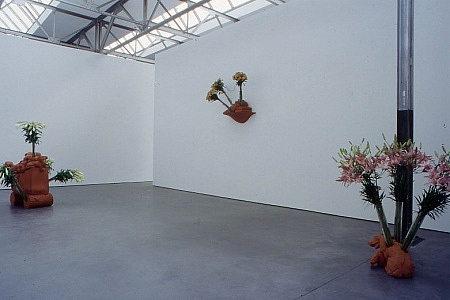Clay is a raw material for potters and ceramists, and its use is associated more with applied arts than with monumental art. Guido Geelen managed to break with that tradition, though his unruly sculptures of clay contain many references to the decorative objects that adorn our living rooms.
Initially Geelen produced sculptures which bear a distinct affinity with the austere order of Minimal Art. The building blocks of Untitled (c.t. 55/15, r+s 63855 zwart, r+s 93602 wit), for example, are stacked into straight columns, which in turn are arranged into the definite, geometric pattern of a checkerboard. The functional subtitles, which refer to the factory codes of the incorporated materials, also belong to the minimalist tradition. But in his use of detail in the sculptures, Geelen deviates from this altogether.
Untitled (r.k. 015) from 1992 looks like a decorative wall; it consists of five large and two smaller elements of bright reddish clay. The building blocks have a peculiar composition, however: one recognizes objects from the household domain, such as television sets, keyboards, vacuum cleaners and kitschy ceramic sculptures of animals – all of which have been thoroughly distorted. The whole of the work looks somewhat like a rubbish heap, chaotic and tidy at the same time, as though the entire muddle of our daily lives has been arranged in an orderly manner.
Little by little, the geometric order gives way to baroque exuberance. What Geelen refers to as the ‘imploding’ sculptures – such as Untitled (r.k. 015) – have given way to ‘exploding’, almost chaotic sculptures in bronze.Untitled (urinals) from 1994, with its irregular growth of protrusions, looks most like an alarmingly large beetle, whose limbs and antennae have been deformed by some grave illness. Those who feast their eyes, however, will notice that the protrusions are made from castings of old-fashioned Dutch clay pipes and that the ‘body’ consists of two joined castings of a urinal.
In his hybrid piece of work, Geelen has not removed the bronze of the many runners (pouring channels for casting), as is normally done in bronze casting. It is typical of Geelen’s refinement that, by leaving the runners intact, he has actually done no more than to make the process of bronze casting visible. Here he applies a pre-eminently modernist principle, that of clarity. Just as a painting is no more than a flat surface with paint, a sculpture is merely a lump of bronze that has been molded. With this surprising work, Geelen has given birth to an anti-modernist-looking monster, by which he defies the strictness of modernism with its own arsenal of weapons. For more information please vist the website of Guido Geelen.
In his hybrid piece of work, Geelen has not removed the bronze of the many runners (pouring channels for casting), as is normally done in bronze casting. It is typical of Geelen’s refinement that, by leaving the runners intact, he has actually done no more than to make the process of bronze casting visible. Here he applies a pre-eminently modernist principle, that of clarity. Just as a painting is no more than a flat surface with paint, a sculpture is merely a lump of bronze that has been molded. With this surprising work, Geelen has given birth to an anti-modernist-looking monster, by which he defies the strictness of modernism with its own arsenal of weapons. For more information please vist the website of Guido Geelen.
